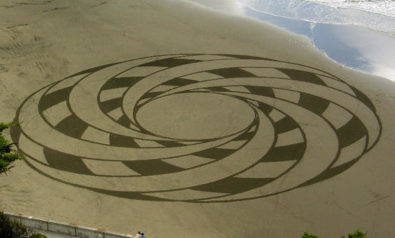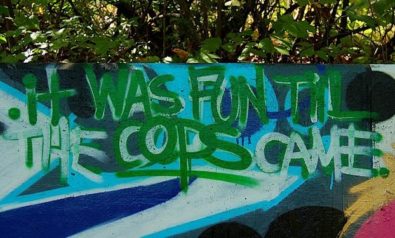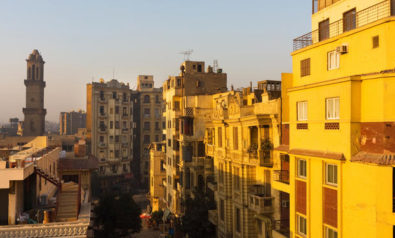Yessi Bello explores the premise that graffiti is a valid form of political activism as opposed to a form of vandalism. The article outlines the reasons why graffiti should be considered as an art form serving as a political commentary of the time, using the Berlin Wall as a case study. This article is the last of a three part series. Read part one here.
The Internationalisation of The Wall
Outside Germany, Berlin represented the struggle between capitalism and communism and the diverging cultures which these entailed. In fact, it was the atypical division of the city that constituted its biggest attraction for foreigners. There are many reasons as to why West Berlin became such an international hub of artists. The most notable one being the transport and living subsidies which West Berlin boasted. In addition accommodation in West Berlin was relatively cheaper than in the rest of Europe and there was the possibility of renting large studios, which accommodated the requirements of aspiring and upcoming artists. The smooth surfaces of the Berlin Wall and the apparent relaxation towards street art in West Berlin proved sufficient for those wishing to participate in the protest to do so. On the other hand, the sole act of residing in the “island” that had become West Berlin in the 1970s and 1980s was considered to be a strong political statement in the struggle against Communism and oppressive regimes world-wide.
The entirety of the Western side of the Wall posed as a multi-purpose bulletin, as well as an experimental canvas for art with political overtones. The Wall’s Western side was therefore considered to be a showcase of peoples’ spontaneity and subsequently became a tourist attraction. Some graffiti begged “Do not disturb History“, which portrayed the Berlin Wall not just as a concern for Germans or Berliners but as an international monument and symbol of the Cold War.
The fact that languages other than German appeared on the Wall leads us to believe that it was vilified in the international arena. English was the most predominant foreign language, although most Western languages were widely represented. This evidences the fact that foreigners felt the need to write on the Wall, which was partly attributable to peoples increasing fascination with the Wall and its consideration as an anachronistic infringement of human freedom. The Wall had become an international concern, which was due to the fact that Berlin had been in the centre of world history and politics, firstly during the Second World War and the Blockade of 1948-1949 and more recently during the Cold War.
The Wall itself had become inseparable from Berlin’s identity. This was because the notion of Berlin as a city was accompanied with the shock of its division during the Cold War, in all its ramifications and it was not long before West Germany and its allies started to exploit the Wall’s propagandistic value as a communist failure. Western leaders claimed that the Wall was anachronistic and that it was primarily designed to contain people and reject progress. The Wall’s ideological elucidation became an integral part of the Wall’s propaganda battle.
The East Side Gallery
The East Side Gallery served as another example of the Berlin Wall’s internationalisation as it became an international freedom memorial. The project was launched after the fall of the Wall in 1989, when hundreds of artists from all over the World arrived with the purpose of changing the east side of the Wall, which had remained untouched until then.
The East Side Gallery can be considered as an international political commentary because it epitomises Germany’s history of division. It is a symbol of overcoming repression, which portrays a time of change and communicates the elation of those wishing for an improved future. As much as the East Side Gallery as a whole represents a collective project of Wall denunciation, its individual art serves as a more explicit political commentary, which is particularly exemplified by the personal motivations of some foreign artists.
Kim Prisu, of Portuguese origin and a French national was one of the one hundred artists who travelled to Berlin after the fall of the Wall, enticed by the possibility of partaking in the project. His reasons for doing so were diverse, but they revolved around the existence and injustice of the Berlin Wall. He explained that as a teenager, he used to say “that it was easier to walk on the moon than to cross the Berlin Wall”. When offered the possibility of coming to Berlin to participate in the project, Kim jumped at the chance as he wished to “paint on the Wall of shame (…) which was the testimony of the madness of power which sometimes imprisons us behind ideologies”. Prisu’s artwork “O Povo Unido Nunca Será Vencido”, a slogan of the Portuguese Revolution of April 1974 (translates as “The United People Will Never Be Beaten”), the result of a highly politicised individual represents the atmosphere which he encountered in Berlin. He claimed that Berlin was different after the fall of the Wall; it was “under a great spirit of freedom”, which reminded him of Lisbon after the Revolution. Overall, Prisu’s work represents peoples’ unity and his use of colour is meant to portray “the joy of happiness and love”. Yet Prisu insists that the original piece which he devised in 1990 was changed significantly when he returned to Berlin in 2009, as he was faced by a completely new emotion. By this time, Prisu claims that his “view of the German people and of the World had changed”. He attempted to convey this by transforming his work into “a world of more colour, with freedom and love”. In order to do so, Prisu then focused on the “union of the German people as opposed to their separation”.
The emergence of street art and graffiti has created very different opinions among the general public, scholars and artists. A close examination of its history and the study of the Berlin Wall as a “white canvas” allows us to conclude that graffiti is essentially both a representative political commentary and a form of political activism.
The issue of its legality and whether it can be considered a vandalist act stems from the physical location of the graffiti, whether it is located in a public or private space. The Berlin Wall was both. It was privately owned by the German Democratic Republic and claimed by West Berliners, who after being confronted with it on a daily basis, began to draw on it in order to manifest their discontent. The Berlin Wall itself was the integral subject of the graffiti’s message and its context. In consequence, it is safe to say that the graffiti on the Berlin Wall was a pre-meditated, purposeful act as opposed to a thoughtless act of vandalism and can therefore be considered an act of political activism.
After comparing the Berlin Wall with Palestine’s West Bank Barrier, we can truthfully say that Walls have often been used as mediums for political activism. Both these barriers exemplify how two different forms of government provided the perfect canvas for street art to appear. The graffiti found on both walls deals with the injustice posed by them and their rejection in the international arena. We have found that the graffiti on both Walls was an act of political activism and in turn we have legitimised the emergence of graffiti and street art, as it provides a valuable commentary of today’s socio-economic and political situation.
The views expressed in this article are the author’s own and do not necessarily reflect Fair Observer’s editorial policy.
Image: Copyright © Shutterstock. All Rights Reserved.
Support Fair Observer
We rely on your support for our independence, diversity and quality.
For more than 10 years, Fair Observer has been free, fair and independent. No billionaire owns us, no advertisers control us. We are a reader-supported nonprofit. Unlike many other publications, we keep our content free for readers regardless of where they live or whether they can afford to pay. We have no paywalls and no ads.
In the post-truth era of fake news, echo chambers and filter bubbles, we publish a plurality of perspectives from around the world. Anyone can publish with us, but everyone goes through a rigorous editorial process. So, you get fact-checked, well-reasoned content instead of noise.
We publish 3,000+ voices from 90+ countries. We also conduct education and training programs
on subjects ranging from digital media and journalism to writing and critical thinking. This
doesn’t come cheap. Servers, editors, trainers and web developers cost
money.
Please consider supporting us on a regular basis as a recurring donor or a
sustaining member.
Will you support FO’s journalism?
We rely on your support for our independence, diversity and quality.










Comment